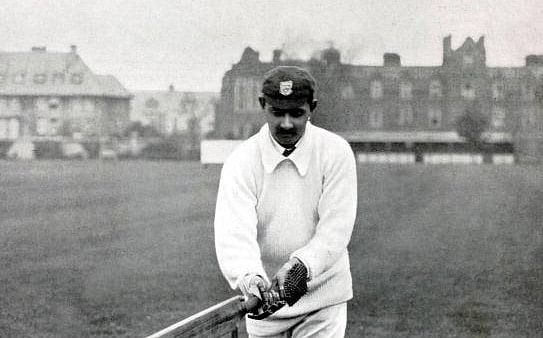Ranji also served as a colonel in the British Army in World War I, and later was the Maharaja of Nawanagar princely state in what is now Gujarat.
K.S. Ranjitsinhji might only be a peripheral figure in the history of official Indian cricket — the premier first-class tournament in the country, the Ranji Trophy, is named after him — but there’s no doubt he was one of the pioneers of the game in India.
Born on 10 September, 1872, in Kathiawar in modern-day Gujarat, Ranji was the first person of Indian origin to play Test cricket when he made his debut for England in 1896.
In doing so, he also set a precedent: Two more cricketers hailing from Indian royal families went on to play for England — his nephew K.S. Duleepsinhji and Iftikhar Ali Khan Pataudi (who later also captained India).
Early career
Ranjitsinhji went to study at Cambridge University in 1891, where he won the ‘Blue’ — an award earned by athletes at university championships for competing at the highest level.
He made his county cricket debut for Sussex at Lord’s in May 1895 by scoring a brilliant 77 and 150 against Marylebone Cricket Club (MCC). Ranjitsinhji scored over a 1,000 runs each in 10 successive seasons for Sussex.
Also read: Ravi Shastri’s free to believe this Indian team is best. But he can’t change the facts
In his county career, Ranjitsinhji was able to amass 72 centuries and 109 half-centuries. He was the highest County Championship run-scorer in 1896, 1899 and 1900. He even managed to get past the 3,000-run mark in 1899 and 1900.
International debut
In 1896, despite having an excellent career for Sussex in county cricket, Ranjitsinhji’s Test debut for England against the touring Australians remained uncertain. Lord Harris, the MCC chief who also served as the principal selector, did not want to field non-white players in the Test match at Lord’s. England lost the match, causing a huge uproar to include Ranjitsinhji in the team.
He was given the opportunity to make his international debut in the next Test at Old Trafford. He went on to score 62 in the first innings and 154 in the second innings, though England lost that Test as well.
However, during England’s tour to Australia in 1897-98, he scored a massive 1,157 runs at an average of 60.89.
Maharaja of Nawanagar
Born in a Jadeja family of Sarodar, Ranjitsinhji had no legal claim to the throne. Vibhaji, the ruler of Nawanagar, made him heir after he decided to disinherit his own son Kalubha for misdemeanour. Ranjitsinhji, thus, became the Maharaja of Nawanagar in March 1907 and retained the throne till 1933.
Known to be a progressive ruler and statesman, he modernised the capital of Jamnagar and played an important role in building roads, railways, and irrigation facilities in the princely state.
During World War I, he served as a colonel in the British Army. In 1920, he represented the Indian states at the League of National Assembly, Geneva. In 1932, Ranjitsinhji also served as the chancellor of the Indian Chambers of Princes.
He was knighted in 1917, 1919, and 1923.
Also read: Cheteshwar Pujara is the indispensable tortoise of Indian batting
Legacy
In 1897, Ranjitsinhji also wrote a classic, The Jubilee Book of Cricket.
He also helped groom his nephew Duleep, who turned out to be a great cricketer for England. The domestic first-class cricket competition Duleep Trophy, started in 1961-62, is named after him.
After playing a major role in bringing cricket to India, Ranjitsinhji died of heart failure on 2 April 1933 at his palace in Jamnagar.



